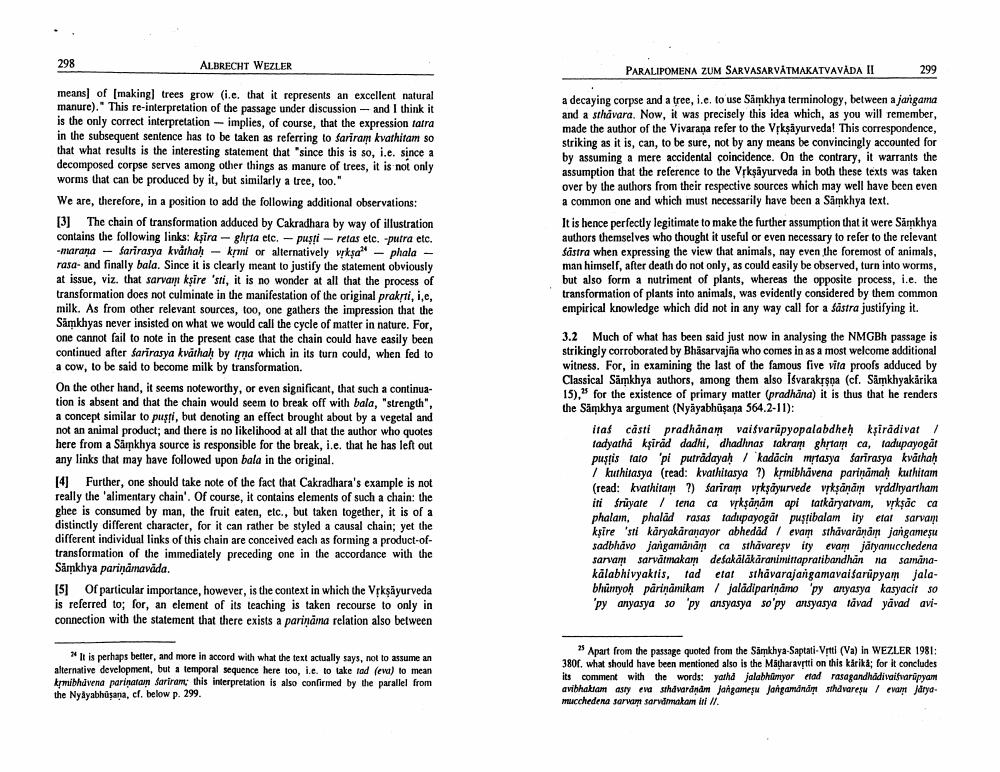Book Title: Paralipomena Zum Sarvasarvatmakatvada II Author(s): A Wezler Publisher: A Wezler View full book textPage 7
________________ 298 ALBRECHT WEZLER means] of [making] trees grow (i.e. that it represents an excellent natural manure)." This re-interpretation of the passage under discussion and I think it is the only correct interpretation implies, of course, that the expression tatra in the subsequent sentence has to be taken as referring to fariram kvathitam so that what results is the interesting statement that "since this is so, i.e. since a decomposed corpse serves among other things as manure of trees, it is not only worms that can be produced by it, but similarly a tree, too." We are, therefore, in a position to add the following additional observations: [3] The chain of transformation adduced by Cakradhara by way of illustration contains the following links: ksiraghṛta etc. puşti retas etc. -putra etc. -marana - Sarirasya kvåthaḥ krmi or alternatively vṛksa phala rasa- and finally bala. Since it is clearly meant to justify the statement obviously at issue, viz. that sarvan kşire 'sti, it is no wonder at all that the process of transformation does not culminate in the manifestation of the original prakṛti, i,e, milk. As from other relevant sources, too, one gathers the impression that the Samkhyas never insisted on what we would call the cycle of matter in nature. For, one cannot fail to note in the present case that the chain could have easily been continued after farirasya kvathah by tma which in its turn could, when fed to a cow, to be said to become milk by transformation. On the other hand, it seems noteworthy, or even significant, that such a continuation is absent and that the chain would seem to break off with bala, "strength", a concept similar to puşti, but denoting an effect brought about by a vegetal and not an animal product; and there is no likelihood at all that the author who quotes here from a Samkhya source is responsible for the break, i.e. that he has left out any links that may have followed upon bala in the original. [4] Further, one should take note of the fact that Cakradhara's example is not really the 'alimentary chain'. Of course, it contains elements of such a chain: the ghee is consumed by man, the fruit eaten, etc., but taken together, it is of a distinctly different character, for it can rather be styled a causal chain; yet the different individual links of this chain are conceived each as forming a product-oftransformation of the immediately preceding one in the accordance with the Samkhya parināmavāda. [5] Of particular importance, however, is the context in which the Vṛkṣayurveda is referred to; for, an element of its teaching is taken recourse to only in connection with the statement that there exists a parināma relation also between "It is perhaps better, and more in accord with what the text actually says, not to assume an alternative development, but a temporal sequence here too, i.e. to take tad (eva) to mean krmibhavena parinatan sariram; this interpretation is also confirmed by the parallel from the Nyayabhusana, cf. below p. 299. PARALIPOMENA ZUM SARVASARVATMAKATVAVADA II a decaying corpse and a tree, i.e. to use Samkhya terminology, between a jangama and a sthavara. Now, it was precisely this idea which, as you will remember, made the author of the Vivarana refer to the Vṛkṣayurveda! This correspondence, striking as it is, can, to be sure, not by any means be convincingly accounted for by assuming a mere accidental coincidence. On the contrary, it warrants the assumption that the reference to the Vṛkşayurveda in both these texts was taken over by the authors from their respective sources which may well have been even a common one and which must necessarily have been a Samkhya text. 299 It is hence perfectly legitimate to make the further assumption that it were Samkhya authors themselves who thought it useful or even necessary to refer to the relevant fästra when expressing the view that animals, nay even the foremost of animals, man himself, after death do not only, as could easily be observed, turn into worms, but also form a nutriment of plants, whereas the opposite process, i.e. the transformation of plants into animals, was evidently considered by them common empirical knowledge which did not in any way call for a fastra justifying it. 3.2 Much of what has been said just now in analysing the NMGBh passage is strikingly corroborated by Bhäsarvajña who comes in as a most welcome additional witness. For, in examining the last of the famous five vita proofs adduced by Classical Samkhya authors, among them also Isvarakṛṣṇa (cf. Samkhyakarika 15), for the existence of primary matter (pradhana) it is thus that he renders the Samkhya argument (Nyayabhüşana 564.2-11): itas casti pradhanam vaiśvarūpyopalabdheḥ kşirādivat / tadyatha kşiräd dadhi, dhadhnas takram ghrtam ca, tadupayogat puştis tato 'pi putradayah / kadacin mytasya farirasya kvathaḥ kuthitasya (read: kvathitasya ?) krmibhävena parināmaḥ kuthitam (read: kvathitam ?) sariram vrkṣayurvede vrkṣānām vṛddhyartham iti früyate / tena ca vṛkṣāṇām api tatkāryatvam, vṛkṣāc ca phalam, phalad rasas tadupayogat puştibalam ity etat sarvam kşire 'sti karyakaraṇayor abhedad / evam sthavarāṇām jangameşu sadbhāvo jangamānam ca sthavaresy ity evam jatyanucchedena sarvam sarvātmakam deśakālākāranimittapratibandhan na samanakalabhivyaktis, tad etat sthävarajangamavaiśarupyam jalabhumyoḥ pārināmikam jaladipariņāmo 'py anyasya kasyacit so 'py anyasya so 'py ansyasya so'py ansyasya tavad yavad avi 25 Apart from the passage quoted from the Samkhya-Saptati-Vitti (Va) in WEZLER 1981: 380f, what should have been mentioned also is the Matharavṛtti on this kårikå; for it concludes its comment with the words: yatha jalabhūmyor etad rasagandhadivaivarūpyam avibhaktam asty eva sthavardṇām Jangameşu Jangamānām sthavareşu evam Jaryamucchedena sarvam sarvämmakam iti //.Page Navigation
1 ... 5 6 7 8 9 10 11 12 13 14 15
